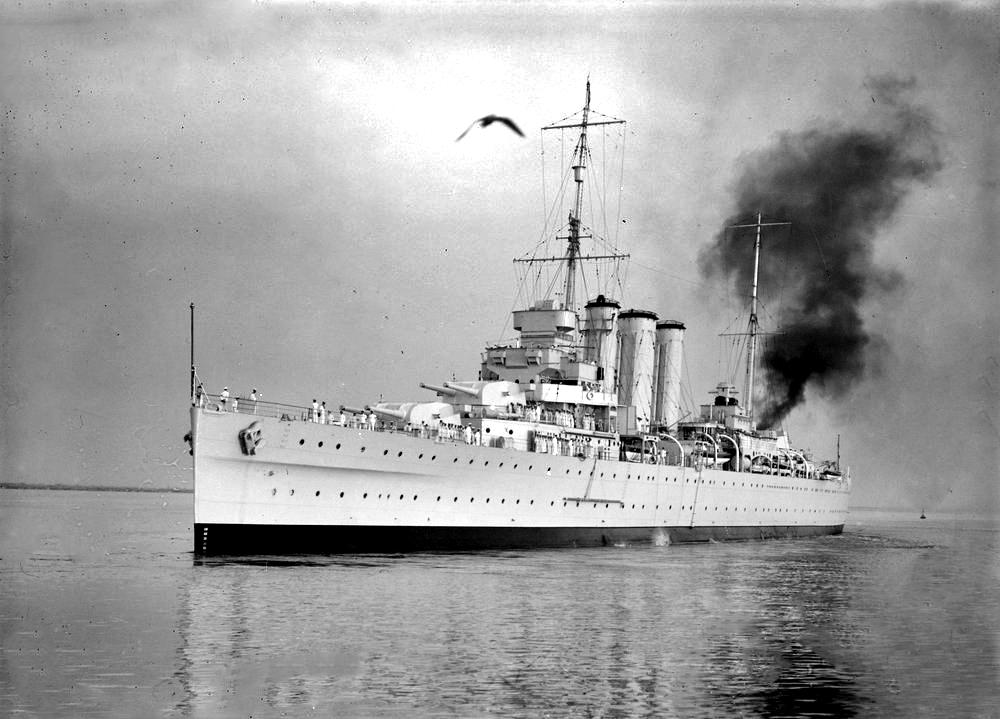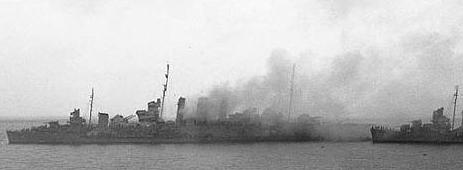September 2017
LCDR Mackenzie Jesse Gregory RAN Ret, (9/02/1922- 27/08/2014) was to my mind a fine example of the qualities a Naval Officer needed to have. He could communicate well, was a leader of men, very resourceful, loyal, and above all a gentleman. I regarded him as a mentor and close friend.
Mac founded his website ‘Ahoy-Mac’s Web log’, http://ahoy.tk-jk.net, around 30 years ago, and he dedicated the site to all ‘Who went down to the sea in ships” in WWII, and especially to the 84 officers and men who died in HMAS Canberra at the Battle of Savo Island on August 9th 1942. This was a very significant date in Mac’s life! He was serving as a Sub Lieutenant in HMAS Canberra and was on the bridge when she was attacked. He has written his account of the Battle of Savo Island, which was initially published by our society as a Monograph. It is 75 years since the Battle and we feel it is most fitting for him to retell the story of those momentous events:
HMAS Canberra and the Battle of Savo Island
We are hit.
I called the Navigating Officer and the Gunnery Officer: the P.C.O. sighted three ships on our starboard bow and gave the alarm and the order to load the 8″ turrets. The Captain quickly arrived to be first to reach the bridge. I sighted torpedo tracks approaching down the starboard side-the Captain ordered full ahead and starboard 35 to quickly swing the ship to starboard. The Navigating Officer reached the bridge and told me he had the ‘Con’, thereby taking over from me. The Gunnery Officer had taken over from the P.C.O. and moved to the Port enemy bearing indicator. Further torpedo tracks crossed the bow. ahead, star shell were lighting up the scene and aircraft dropped flares to starboard. As I left the bridge, we again altered course.
I hurried to my action station in the fore control-there was an explosion amidships, we were hit on the 4″ gun dock, the Walrus aircraft was blazing fiercely on the catapult. A shell exploded on the port side just below the compass platform and another just aft of the fore control. The plotting office received a direct hit. The shell that demolished the port side of the compass platform mortally wounded the Captain, killed Lieutenant Commander Hole, the gunnery officer, wounded Lieutenant Commander Plunkett-Cole, the Torpedo Officer and severely wounded Midshipmen Bruce Loxton and Noel Sanderson. I had virtually been surrounded by shell hits but luckily remained unscathed. In the fore control standing beside me, Able Seaman Oliver was hit from the explosion just aft of our position-he was given morphine but was a very sick young man. The ship had now lost power and took on a noticeable list to starboard. For Canberra, the war was over. Only 2-3 minutes had elapsed since the ship went to action stations.

Chicago had about 16 feet of her bow blown off by another torpedo but she could still steam and the bulkheads held. she charged off to port but did not in fact fire her 8″armament-she fired star shell from her port and starboard 5″ guns in the direction of her perceived position of an enemy cruiser-none of these star shells functioned. Chicago did not apparently warn the northern cruiser force, but I will return later to this ship’ movements and actions.
Patterson had sighted the enemy and quickly broadcast on her T.B.S.” Warning, Warning, Strange Ships Entering Harbour”. You will recall earlier I indicated Canberra was not fitted with T.B.S. so that warning was not received by us. She had also signalled to using a small blinker tube. Patterson had opened fire, but an order to fire torpedoes was not heard, the noise of her guns firing swamped out this command given by her Captain. Patterson was illuminated by the Japanese, fired upon, and hit. However Patterson did get off star shell and 50 rounds of gunfire.
Bagley sighted the Japanese after Patterson and altered course to port so she could fire torpedoes. But she swung too far before the primers were inserted,
It took another 3 or more minutes to bring her starboard tubes to bear and 4 torpedoes were fired , but without any positive result. Bagley also proceeded to the west but Mikawa* had long gone.
After Mikawa* had decimated the Southern force, he swept on, split into 2 groups and opened fire on the Northern Cruisers at 0150 and 0200. Twice Chokai was hit, but not impeded. By 0240 the 2 Japanese groups were clear, they rejoined as one and made off for Rabaul and Kavieng at high speed. ( * Vice Admiral Gunichi Mikawa was in command of the IJN heavy cruisers. R W )
Quincy sank at 0235,Vincennes at 0250 and, finally the last of the Northern cruisers sank at 1215 on 9 August. Ralph Talbot was also damaged as the Japanese withdrew. Wilson was an escorting destroyer with the Northern force and her report after the battle is an amusing comment: ‘The times inthe above narrative are approximate, for the hands fell off the bridge clock on our first salvo and it was not realised that the Quarter master was not making exact time records of the occurrences until sometime later.”
Back to the Canberra
We were blazing amidships with 4″ ammunition exploding and we had developed a severe list to starboard. There was no power and no water pressure for fire fighting. The fore-control was abandoned and I went to assist with the wounded and dump ammunition. At one stage, I went below decks in the vicinity of the Sick Bay flat-it was a shambles below. There were no lights, I used a torch but the list made it difficult to proceed. Whilst I was below decks, the ship gave a shudder and suddenly took an even greater list to starboard. I feared Canberra was about to capsize, I would be trapped and that was the end of me. However the ship steadied and I scrambled back to the upper deck and survival. I tried to move to the stern but could not pass the fierce fires amidships.
My Embroidered Cap Badge and Bruce Loxton
Even in times of crises, one acts quite illogically. During my Sub Lieutenant’s courses in England, I had purchased a gold embroidered cap badge from “Gieves”, the famous Naval outfitters. The officer cap badges available in Australia were, at this stage, stamped out of metal. I prized my Special cap badge and on reaching my action station in the fore control, I had thrown my cap and badge into a corner to don my tin hat. I decided to try and retrieve my cap and badge. I made my way up to the starboard side of the bridge area and finally scrambled up to the fore control, alas, no cap or badge, just a large hole where I had discarded them – so much for foolish pride. On my way down, I came across two sailors with a body on a stretcher. They were lifting up this person to drain away the trapped blood. On investigation I made out Bruce Loxton, who was the Captain’s Midshipman on the bridge, had been severely wounded. Bruce had ghastly wounds and I did not believe he would survive. He was conscious and I said “How are you Bruce?” His response was “I will be all right ” and his fighting spirit pulled him through. He survived and continued as an Executive Officer in the RAN, to retire as a Commodore.
Patterson to the Rescue
At about 0330, Patterson came alongside our port side forward of the 4″Gun Dock. She provided pumps and hoses for fire fighting and proceeded to take on board wounded from the fore half of Canberra. Captain Getting was amongst those removed to Patterson. We were informed by Patterson that Rear Admiral Turner had indicated if Canberra could not steam by 0630, she would have to be abandoned and then sunk. At 0430, Patterson ordered all lights to be extinguished- she had sighted a hostile ship on her Port Quarter so she quickly slipped or cut all lines. I vividly recall her Captain’s reassuring words “don’t worry, we’ll be back.” As Patterson quickly got underway, the enemy ship opened fire. I still had my 1900 binoculars (from the fore control) around my neck. I quickly used them and recognised Chicago – she had mistaken Canberra for a burning Japanese cruiser. Patterson used her searchlight and exchanged fire with Chicago before their true identity was established. Both ships ceased fire. Another error in a night that may well be described as a comedy of errors – but then, we did not have much to laugh about. It commenced to rain to add to our discomfort. At about this time, the ship’s list suddenly increased and Lieutenant Commander Mesley ordered “stand by to abandon ship”, I discarded my boots but kept my binoculars. Canberra steadied and the final order to leave was not given-at that time. I put on my boots again.
Survivors Removed
As daylight broke over the area, Patterson, keeping her promise, returned and secured Starboard side Aft and proceeded to take on board the ship’s company gathered there. Blue secured to the port side Forward and took off the rest of Canberra’s crew, including myself; the time was about 0630. Blue transferred her load of survivors to the transport Fuller whilst Patterson transferred her survivors to Barnett.
Sinking of Canberra
I did not actually see Canberra sink, but Gill in his book “Royal Australian Navy 1942-45″reports that the US destroyer Selfridge, attempting to sink Canberra, fired some 263x 5” shells and 4 torpedoes. It was left to the USS Ellet to administer the coup de grace with one of her torpedoes and at 0800, our ship finally slipped beneath the waves: at last she was gone.

Post Script:
We end our transcription of Mac’s account of the Battle of Savo Island. It was taken directly from Mac’s website Ahoy-Mac’s Web Log. This is an excellent Historical resource and we suggest you check it out. Mac was a skillful orator who made history come alive for his audience. I have heard Mac’s account of the sinking of his beloved HMAS Canberra a number of times, but never tired of hearing it! I count myself privileged to have been his close friend and colleague.
by Rex Williams




